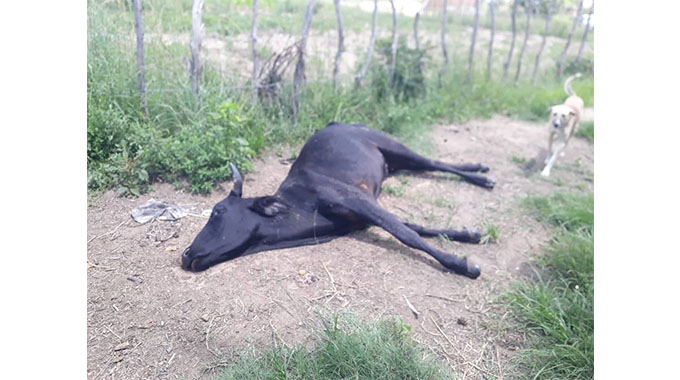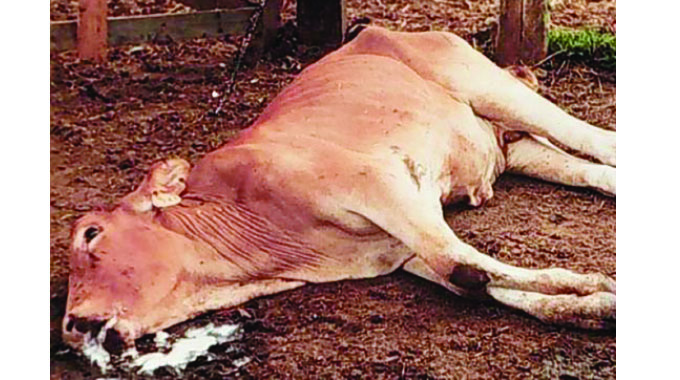January disease kills 130 cattle in Midlands

Midlands Bureau Chief
MORE than 130 cattle in the Midlands province have succumbed to Theileriosis, better known as the January disease, with Shurugwi district being the most affected.
This follows reports that over 80 cattle in Insiza District succumbed to the disease since the beginning of this month.
Now, farmers in the Midlands province are battling to contain the disease which has become a perennial challenge across the region.
Theileriosis is caused by a parasite, theileria parva, which is transmitted between cattle by ticks.
The disease is responsible for huge economic losses in cattle assets and farm savings in Zimbabwe as it accounts for more than 60 percent of cattle deaths in the country.

Some of the dead cattle in Fort Rixon, Insiza District
Signs of an animal affected by January disease include swelling of the lymph nodes under the ears and on the shoulder, cloudiness of the eyes and difficulty in breathing with froth from the nose and mouth.
The affected animal collapses and dies within a few days. The hallmark in the control of theileriosis, like all other tick-borne diseases, is to control the tick sector.
The Government is urging farmers to intensify dipping and application of tick grease to their livestock as a prevention measure.
In an interview yesterday, Midlands provincial veterinary officer, Doctor Martin Sibanda confirmed the deaths of the cattle.
“I confirm that more than 130 cattle in the Midlands province have succumbed to theileriosis, better known as the January disease, with the Shurugwi district the most affected,” he said.
Dr Sibanda said the disease is not easy to contain, with farmers being urged to practice proper farming methods in dealing with the scourge.
“The problem with Theileriosis disease is that it’s becoming a career disease which recurs over time. In this province, Shurugwi is the most affected and we have also been advised of other areas like Mvuma, Lalapanzi, Zvishavane and Mberengwa around the Neta area. We recommend that farmers do intensive dipping and application of tick grease as a way to control the disease,” he said.

Dr Enat Mdlongwa
Dr Sibanda said Government has since dispatched the necessary vaccines to deal with the outbreak in problematic areas.
“On our part, we have dispatched the required medicine which will last the next two months. However, we urge farmers to invest in medicine to deal with this disease all the time. Farming is a business and as such, we need to put in place mechanisms to protect such wealth,” he said.
This week, Matabeleland South provincial veterinary services director, Dr Enat Mdlongwa said over 80 cattle in Insiza District succumbed to theileriosis since the beginning of the month.

Dr John Lands, Agriculture, Fisheries, Water, Climate and Rural Development Permanent Secretary Dr John Basera
Dr Mdlongwa said theileriosis, which was usually recorded in Mashonaland provinces, Manicaland, Midlands and Masvingo, was recorded for the first time in the province last year with Insiza District being the only affected district.
Lands, Agriculture, Fisheries, Water and Rural Development Permanent Secretary, Dr John Basera said about 80 percent of households derive their livelihoods from livestock and their products, hence the need to preserve livestock.
Agriculture occupies a central place in Zimbabwe’s economy and has the potential to significantly reduce poverty, enhance economic growth and entrench economic stability.
Last year, the Midlands province lost over 700 cattle to the January disease which has seen the Government and its development partners put in place mechanisms to minimise loss.
Last year, the country launched the Tick and Tick-borne Disease Control Strategy (2022-2030) in order to fight against a myriad of livestock diseases that pose a threat to the livestock industry.












Comments